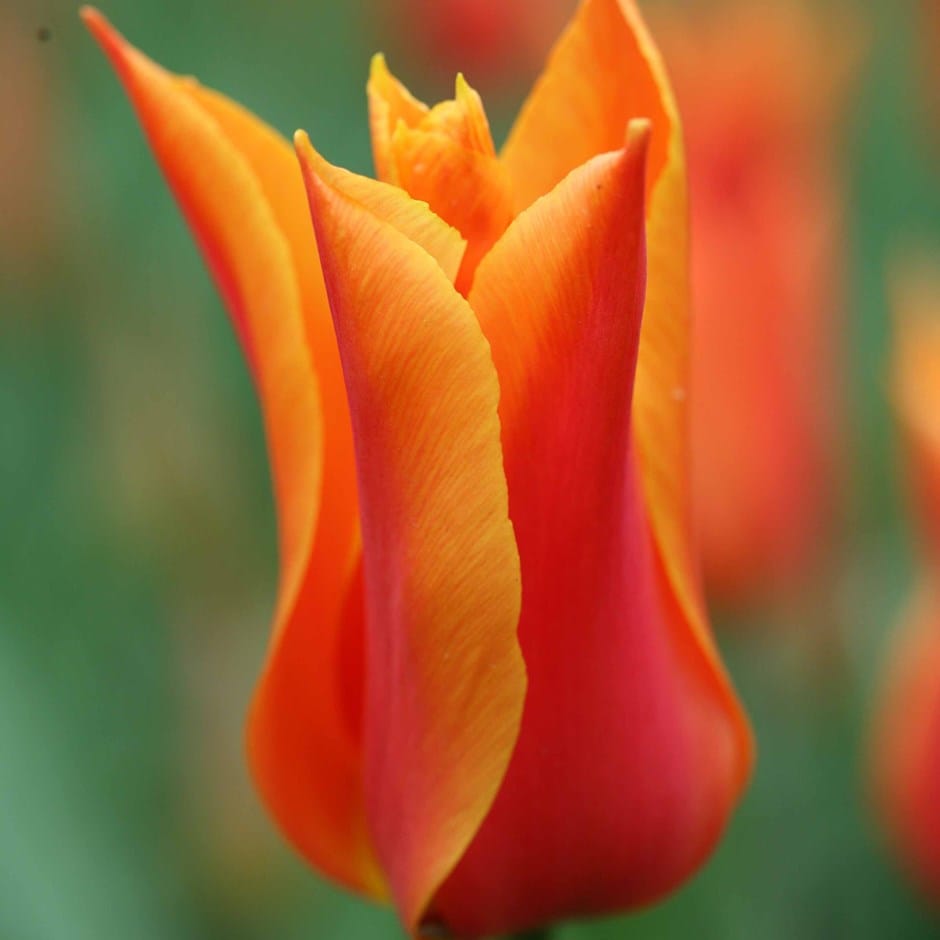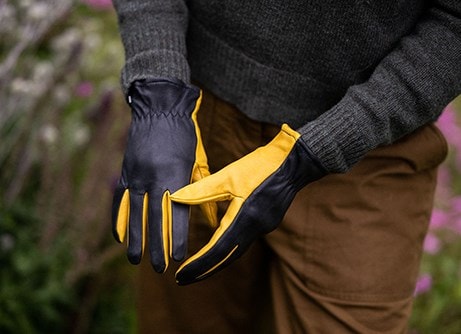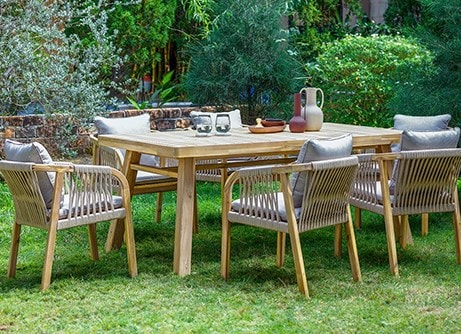
Elegant and eye-catching, this gorgeous Lily-flowered tulip makes an exceptional addition to the late spring garden. An award-winning cultivar, Ballerina’s luminous tangerine flowers top tall (55cm or so) stems, which rise above clumps of grey-green foliage.
The flowers have a svelte silhouette, with pointed petal tips that become more splaying as the flowers mature, and a sweet perfume, which makes them perfect for placing near seating areas or entrances.
Plant in abundance so you can cut some for the vase without making a dent in display.
Wallflowers also make terrific partners for orange tulips, and the Sweetly fragrant wallflower collection contains a trio of ‘Sugar Rush’ cultivars in shades of red, yellow and purple. Together they’ll put on a riotous display.
If you'd like to lengthen the bulb season, you could create a succession of colour lasting from January to July by pairing tulip ‘Ballerina’ with snowdrops, crocus, grape hyacinths, daffodils and alliums. This will work equally well in borders, or as ‘bulb lasagnes’ in large pots.
Finally if you simply love the out and out opulence of tulips and just want more, mix it with those that have either harmonious or boldly contrasting colours - or those that have differently shaped flowerheads.
The flowers have a svelte silhouette, with pointed petal tips that become more splaying as the flowers mature, and a sweet perfume, which makes them perfect for placing near seating areas or entrances.
Plant in abundance so you can cut some for the vase without making a dent in display.
Late-spring flowering tulips
Typically in bloom for a month or so from late April or early May, Tulipa ‘Ballerina’ is a late-flowering tulip, so it’s flawlessly timed to span those few weeks between the seasons. Therefore, it’s a great choice if you want to keep displays looking fresh and exuberant while the garden's focus shifts from the riotous colours of spring to the emergence of early summer perennials.Perennial tulips
Also, as this short-lived perennial tulip can be left in the ground year after year, it's a great choice for more sustainable planting schemes.Goes well with pairings
This striking ballerina tulip can be incorporated into the planting scheme in so many ways. In mixed or perennial borders, try pairing it with lower-growing, early-flowering perennials such as Euphorbia epithymoides or Brunnera macrophyllaWallflowers also make terrific partners for orange tulips, and the Sweetly fragrant wallflower collection contains a trio of ‘Sugar Rush’ cultivars in shades of red, yellow and purple. Together they’ll put on a riotous display.
If you'd like to lengthen the bulb season, you could create a succession of colour lasting from January to July by pairing tulip ‘Ballerina’ with snowdrops, crocus, grape hyacinths, daffodils and alliums. This will work equally well in borders, or as ‘bulb lasagnes’ in large pots.
Finally if you simply love the out and out opulence of tulips and just want more, mix it with those that have either harmonious or boldly contrasting colours - or those that have differently shaped flowerheads.
Collections included in
We’ve put together four collections that feature the ballerina tulip. The "Chocolate orange tulip collection" pairs it with the ever-popular, inky purple 'Queen of Night' to create a mouth-watering contrast, while the "Award-winning technicolour tulip collection" creates a jewel-box like effect. For rich, opulent displays, the "Award-winning repeat flowering tulip collection" or the "Repeat-flowering and award-winning quartet tulip collection" will deliver.How to care for Tulipa Ballerina:
Tulip bulbs can be planted in pots or borders from September to December, although to decrease the risk of infection from potential diseases that can linger in warmer soils, we recommend waiting until after the first frosts when planting in the ground.
If you’re not able to plant your bulbs soon after they arrive, you can keep them stored in a cool dry place until you’re ready.
They’re happiest when planted 10-15cm deep in a sheltered, sunny spot with fertile, freely draining soil, so if necessary prepare your borders before planting by digging in some composted organic matter.
For best effect plant the bulbs pointy side up in generous, oddly numbered clusters or drifts allowing approximately 7 to 9 bulbs per 30cm sq.
When planting in pots, use a fresh, good-quality potting compost and plant deeply (and a little more densely) in layers to create a ‘tulip lasagne’. In this way you could use up to 20 bulbs in a 45cm pot to create a really generous display.
After planting, water them in well and wait. Then, in spring, just as the growth is starting to emerge, apply a general-purpose fertiliser such as Growmore or Vitax Q4.
As the last petals fall, remove the spent flowerhead, but make sure the foliage is left to die back naturally before it’s tidied away.
If you’re not able to plant your bulbs soon after they arrive, you can keep them stored in a cool dry place until you’re ready.
They’re happiest when planted 10-15cm deep in a sheltered, sunny spot with fertile, freely draining soil, so if necessary prepare your borders before planting by digging in some composted organic matter.
For best effect plant the bulbs pointy side up in generous, oddly numbered clusters or drifts allowing approximately 7 to 9 bulbs per 30cm sq.
When planting in pots, use a fresh, good-quality potting compost and plant deeply (and a little more densely) in layers to create a ‘tulip lasagne’. In this way you could use up to 20 bulbs in a 45cm pot to create a really generous display.
After planting, water them in well and wait. Then, in spring, just as the growth is starting to emerge, apply a general-purpose fertiliser such as Growmore or Vitax Q4.
As the last petals fall, remove the spent flowerhead, but make sure the foliage is left to die back naturally before it’s tidied away.
Flowering period:
- Jan
- Feb
- Mar
- Apr
- May
- Jun
- Jul
- Aug
- Sep
- Oct
- Nov
- Dec
Eventual height:
0.55m
Eventual spread:
0.1m
Position:
Full sun
Rate of growth:
Average
Soil:
Moderately fertile, moist, well-drained soil
Hardiness:
Fully hardy
-
This bulb dies back after flowering each year and enters a period of rest ahead of regrowth the following season.
-
Humans: Harmful if eaten; skin allergen; Pets: Ornamental bulbs - not to be eaten
Product options
Delivery options (pick your preferred option at checkout)
Goes well with
Bulb planting auger - long
From £7.99
View options
| set of 3, save £6 | £29.97 |
|
| large | £15.99 |
|
| medium | £11.99 |
|
| small | £7.99 |
|
View details
Bulb planting auger - short
From £6.99
View options
| medium | £11.99 |
|
|
| large | £14.99 |
|
|
| small | £6.99 |
|
|
| set of 3, save £5 | £28.97 |
|
View details
Euphorbia × martini
Martin's spurge
From £9.99
View options
| 2 litre pot | £22.99 |
|
|
| 3 × 2 litre pots | £54.99 |
|
|
| 9cm pot | £9.99 |
|
|
| 3 × 9cm pots | £23.99 |
|
View details









